Paranormal
Patience Worth
Pearl Lenore Curran wrote four novels and many poems, but claimed that they had all been dictated to her by a woman named Patience Worth who had lived over two hundred years earlier. So, A body of work that was literally ghost-written.Info from Superstition and the Press (1983) by Curtis MacDougall:
Note: the Patience Worth poems were included in Braithwaite's 1918 anthology, not the 1917 one.

More info: Wikipedia, Smithsonian magazine
You can also find the Patience Worth novels on archive.org.
Posted By: Alex - Wed Jun 12, 2024 -
Comments (1)
Category: Literature, Books, Poetry, Paranormal
Rosemary Brown’s Music
At first glance the 1970 album Rosemary Brown's Music might have seemed just like a collection of classical music. The track list included composers such as Liszt, Chopin, and Beethoven, but looking closer one would see that the various tracks were merely "inspired by" these composers.And there was the odd twist. Rosemary Brown claimed that the ghostly spirits of famous composers had dictated the songs to her. Brown insisted that she herself had almost no musical ability. She was merely the conduit through which musical ghosts were sending the living world new music.

She also claimed that Liszt would watch television with her and would occasionally appear to her while she was at the supermarket. Apparently he was very curious about the price of bananas.
More info: interlude.hk

Saskatchewan Leader-Post - May 28, 1970
Click to enlarge
Posted By: Alex - Tue Feb 27, 2024 -
Comments (0)
Category: Music, Paranormal
Doris Munday, the woman who controlled the weather
When she was in her forties, Doris Munday realized that she had the power to control the weather. All she had to do was look at a location on a map, visualize what kind of weather it needed, and then concentrate hard. The weather would obey her command.
Shepherds Bush Gazette - Oct 7, 1971
This power came with a cost. Controlling the weather would leave her feeling fatigued, and it also seemed to cause her bad luck. After she had sent rain somewhere, her washing machine might blow up, or someone would run into her car.
She also felt that she didn't get enough credit for her powers. She complained, "Everyone always says when the rain falls, 'Oh well, it is a coincidence isn't it', and I don't even get a thank you for my time and trouble."
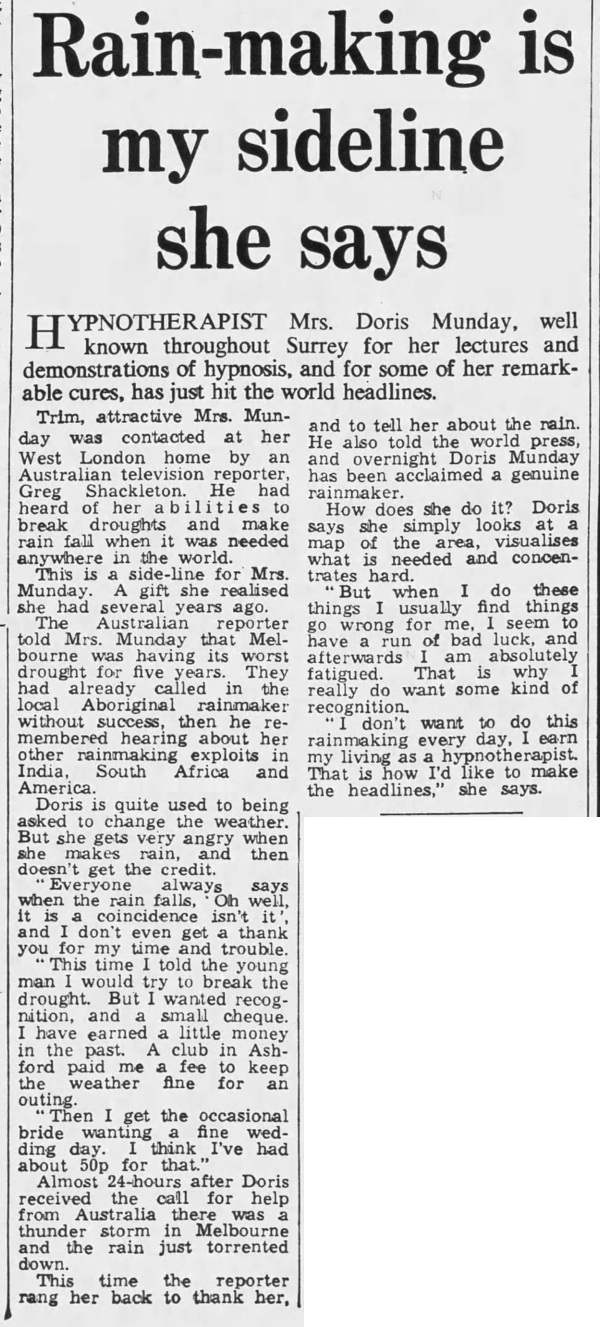
Hounslow Middlesex Chronicle - Jan 26, 1973

Daily Mail - Jan 24, 1973
And on occasion she made mistakes. She once wanted to send rain to South Africa, but accidentally sent it to Rhodesia instead.

Hamilton Spectator - Jan 22, 1973
She confessed that she didn't know why her powers worked, they just did. She speculated, "I think I have stumbled on some kind of electrical force which is rarely known."

The Guardian - Dec 23, 1968
Posted By: Alex - Thu Dec 28, 2023 -
Comments (1)
Category: Eccentrics, Paranormal, Weather
Twin Telepathy
1965: Two eye doctors published an article in the journal Science detailing what appeared to be a form of telepathy found in two sets of twins. The brainwaves of the twins seemed to be linked. When the brainwaves of one changed (by having him close his eyes), the brainwaves of the other twin would change also, even though the two were in separate rooms.The doctors examined 16 sets of twins, but only found the linked brainwave phenomenon in two of them. Why these two? The doctors speculated that they were "serene" whereas the other twins demonstrated "impatient anxiety and apprehension about the testing procedure."
It's surprising the doctors got their article published in Science, since that journal doesn't usually consider anything that smacks too much of parapsychology.
You can find a copy of their Science article ("Extrasensory Electroencephalographic Induction between Identical Twins") here.
More info about twin telepathy at Psi Encyclopedia.

Los Angeles Times - Dec 22, 1965

Science - Oct 15, 1965
Posted By: Alex - Sun Nov 12, 2023 -
Comments (5)
Category: Paranormal, Science, Psychology, Twins, Lookalikes & Doppelgangers, 1960s
Healing Mummified Hand
Although the mummified hand supposedly healed 500 people, I've only been able to find one description of a "cure":
Saskatoon Phoenix - Feb 8, 1928
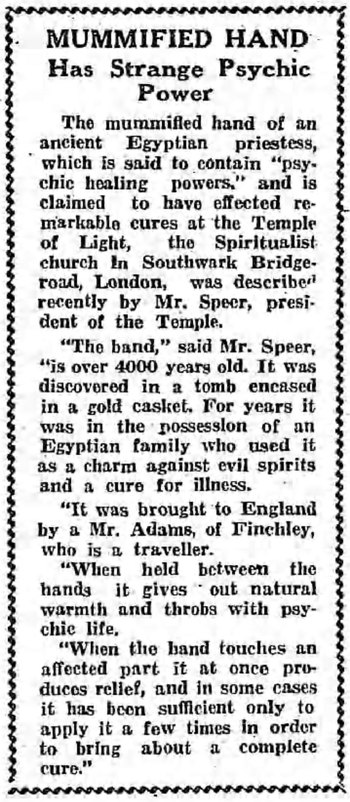
Sydney Sunday Times - Feb 5, 1928
Posted By: Alex - Tue Sep 12, 2023 -
Comments (1)
Category: Paranormal, Patent Medicines, Nostrums and Snake Oil, 1920s
Bad perm caused loss of psychic powers
Oct 1950: Jacqueline Sisson sued her hairdresser for $20,000, alleging that scalp burns she suffered while getting a permanent wave caused her to lose the psychic powers she relied upon for her stage act. Specifically, she had lost the ability to know what musical tunes audience members were thinking of.As is typical of stories like this, the media never ran a follow-up to report the outcome of her lawsuit.

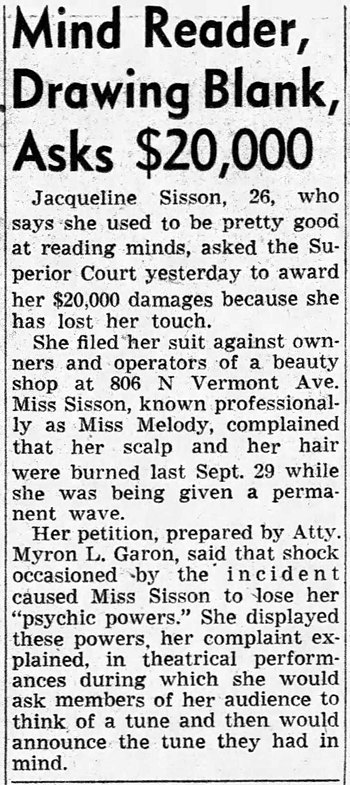
Los Angeles Times - Oct 12, 1950
Posted By: Alex - Sun May 21, 2023 -
Comments (0)
Category: Paranormal, Predictions, Lawsuits, 1950s
ESP Girl
In November 1964, 5-year-old Kenneth Mason went missing. The police searched the river where he was last seen, but failed to find him.Then 15-year-old Linda Anderson came forward and offered to use her psychic powers to help the police find Kenneth. Her father put her in a hypnotic trance, to activate her powers, and she declared, "The boy is not in the river, but is in a house." So the police began searching houses in the area.

Charlotte Observer - Nov 14, 1964

Linda Anderson, ESP Girl
In addition to being able to locate missing children, Linda also claimed to have the power of "dermal optical perception." She could read through her skin (as opposed to through her eyes). The media dubbed her "ESP Girl."

Lewiston Daily Sun - Nov 14, 1964
A skeptical physics professor, James A. Coleman, doubted that she could see through her skin and challenged her to prove it.

Bangor Daily News - Feb 11, 1965
She lost the challenge.
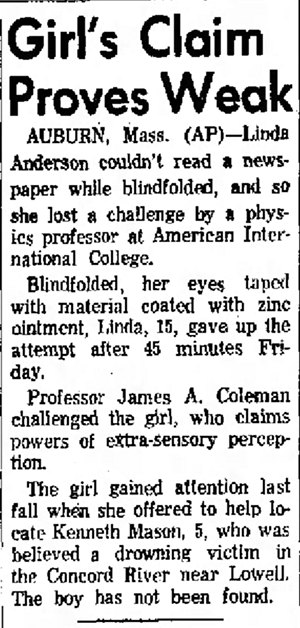
Nashua Telegraph - Feb 15, 1965
And then Kenneth Mason was found. Sadly he was dead and in the river after all. So much for the powers of ESP Girl.

Daily Kennebec Journal - Mar 12, 1965
Posted By: Alex - Tue Apr 04, 2023 -
Comments (2)
Category: Crime, Paranormal, Predictions, 1960s
Death By Yoga?
Robert Antoszczyk died on June 3, 1975. That much everyone agrees on. But how he died is more controversial.
Robert Antoszczyk
Initial reports claimed that he went into a yogic trance and projected his spirit out of his body, but that he didn't know how to re-enter his body. So he died. This explanation remains popular with the Fortean crowd.
The official explanation, which emerged later, is that he died from a cocaine overdose. However, his friends and family always contested this, insisting that he was very much into clean living and never drank, let alone took drugs.
Over at medium.com, Nick Ripatrazone has an article in which he explores this case, as well as the broader interest in 'astral projection' during the 1970s.

Palladium Item - June 30, 1975
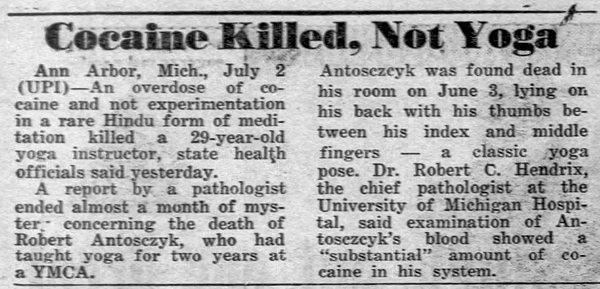
NY Daily News - July 3, 1975
Posted By: Alex - Fri Jun 03, 2022 -
Comments (0)
Category: Death, Forteana, Paranormal, 1970s
The housewife who became pregnant after watching Uri Geller
March 1974: a Swedish housewife claimed that, after she watched Uri Geller on TV, her contraceptive coil got bent out of shape, thereby causing her to become pregnant.Given that the housewife was never named, I'm going to assume this story sprang from the overly fertile imagination of the "Sunday Mirror Reporter in Stockholm".
Uri Geller references the event in his biography, posted on his website, but gives no more details than are available in the Sunday Mirror story, which suggests that, at the very least, he was never sued by the Swedish housewife.
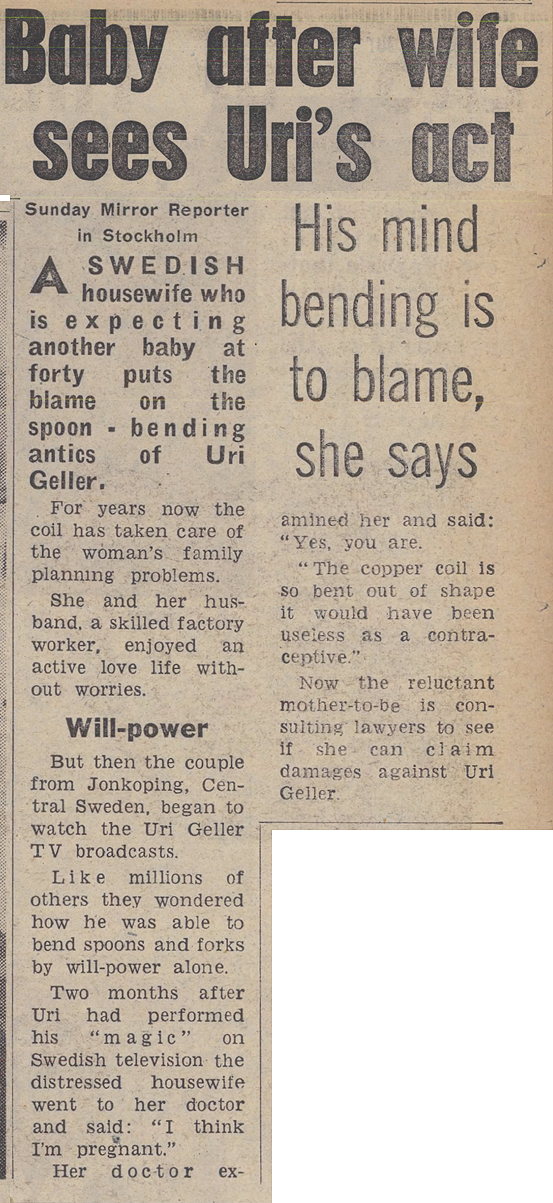
Sunday London Mirror - Mar 17, 1974
Posted By: Alex - Sun Apr 10, 2022 -
Comments (2)
Category: Paranormal, 1970s, Pregnancy
Swindle’s Ghost
'Swindle's Ghost' is a term for an optical illusion that some psychologists have offered as a possible scientific explanation for ghost sightings. Actually, I doubt that many sightings are a result of this phenomenon, but I like the name.Newsday Special Correspondent Paul Brock (May 15, 1967) offered this explanation:
It can be summoned up by anybody. Using no more ectoplasm than a table lamp, friends can join you in this weird experiment, right in your own living room. Choose a dark moonless night and draw the drapes securely so that no stray light from street lamps or passing cars enters the room. Group the chairs near a table or floor lamp with one person directly alongside it to switch it on and off.
First, everyone must remain in the darkened room for at least 10 minutes before the experiment begins, so that the eyes can adjust completely to the darkness. Then, each ghosthunter must look steadily toward the lamp but not directly at it. They must keep perfectly still and keep the eyes from moving during the time the room will be illuminated and immediately afterward.
Now turn on the lamp for a full second. Turn it off. Shortly after you will see the whole scene loom up in the darkness with startling clarity, and the ghost impression will last for some time. Not only will everything appear exactly as it was when the light was on, but many precise details will be evident which could not possibly have been noted during the brief illumination...
The same optical illusion occurs when someone reports that he has seen a ghost in a graveyard at night. If a man is passing a graveyard at night and the moon breaks through the clouds just as he is opposite a white tombstone, in a few minutes he might see a vague white form loom up before him. The moon's illumination has created the 'ghost' which the man actually does see, but which is only an after-image— in the image of "Swindle's Ghost."
Some more info in the book Systems Theories and A Priori Aspects of Perception:
You can find Swindle's original article here:
Swindle, P.F. (1916). Positive Afterimages of long duration. American Journal of Psychology, 27, 325-334.
Posted By: Alex - Tue Jun 15, 2021 -
Comments (0)
Category: Paranormal, Supernatural, Occult, Paranormal, Psychology, Eyes and Vision

| Who We Are |
|---|
| Alex Boese Alex is the creator and curator of the Museum of Hoaxes. He's also the author of various weird, non-fiction, science-themed books such as Elephants on Acid and Psychedelic Apes. Paul Di Filippo Paul has been paid to put weird ideas into fictional form for over thirty years, in his career as a noted science fiction writer. He has recently begun blogging on many curious topics with three fellow writers at The Inferior 4+1. Contact Us |




